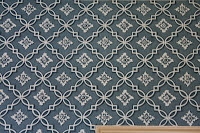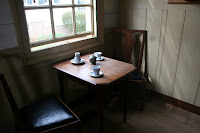
Our next stop was to the R. Charlton's Coffeehouse which in November 2009, became the newest reconstructed building on Duke of Gloucester Street in 50 years. An authentic 18th-century coffeehouse, this exhibition building is now open to ticketed guests. R. Charlton's Coffeehouse is located just across from the Capitol.
On the same site more than 240 years ago, a Williamsburg wigmaker named Richard Charlton operated a popular coffeehouse, just a few steps from the colonial Capitol. Over cups of coffee, chocolate, and tea, Williamsburg’s gentlemen and politicians gathered to make deals, discuss business, learn the news from England, and exchange the latest gossip.
 |
| Carpet |
 |
| Our tour began here |

Here we got a tour of the rooms that had been considered for public and private use in the 18th century.
As well as Mr Charlton's office, in the last room we toured several table were set up where we could all sit and try either coffee or Hot Chocolate as it would have been in that time period. It was very good Hot Chocolate, we went down to John Greenhow's Shop to purchase some.
 |
| Charlton desk |
 |
| Wallaper |


 Next was the Capitol, the building that stands today is substantially the same as Cary's, but it is the third Capitol on the site. To hinder the threat of fire, the second Capitol was built without fireplaces. Candles and pipes were barred. But in 1723, the secretary complained that the building was damp, so chimneys were added for fireplaces to help keep the Capitol dry. Between 7:00 and 8:00 a.m. on January 30, 1747, someone noticed that the building was burning. When the flames died, only some walls and the foundation remained.
Next was the Capitol, the building that stands today is substantially the same as Cary's, but it is the third Capitol on the site. To hinder the threat of fire, the second Capitol was built without fireplaces. Candles and pipes were barred. But in 1723, the secretary complained that the building was damp, so chimneys were added for fireplaces to help keep the Capitol dry. Between 7:00 and 8:00 a.m. on January 30, 1747, someone noticed that the building was burning. When the flames died, only some walls and the foundation remained. |
| A meeting in the Council Chamber. |
In March, Governor William Gooch urged that the Capitol be rebuilt, but many legislators preferred moving the government to a city more accessible to trade and navigation. In the meantime, the burgesses met at the Wren Building. The General Court took up residence in City Hall – a building that had a few years before served as the first theater in America. When a vote was taken on November 23, 1748, reconstruction of the Capitol was approved by two votes: 40 to 38.
John Blair wrote in his diary on April, 1751, that he had laid a foundation brick for the second Capitol. On December 12 he put a brick atop a finished wall. The south ends of the new structure were squared, and the western entrance got a two-story porch that more plainly designated it as the main entrance. The burgesses met inside for the first time on November 1, 1753.
 |
| A trial in the General Court. |
In this building Patrick Henry delivered his "Caesar-Brutus" speech against the Stamp Act on May 29, 1765. Henry, George Washington, George Mason, George Wythe, Richard Henry Lee, Jefferson, and others played their parts in the legislative wars that ended in revolution.
There were lighter moments. Both Capitols were the scenes of dances, suppers, and other social events. But as fighting erupted in the North, the building rang to the debates over Mason's Declaration of Rights, his Virginia constitution, and Jefferson's first attempt at a bill for religious freedom.
The building was last used as a capitol on December 24, 1779, when the General Assembly adjourned to reconvene May 1 at the new capital, Richmond. By turns the building served as an admiralty court, a law school, a military hospital, a grammar school, and a female academy. The west wing was sold for its bricks and demolished in 1793; the east burned in 1832. In 1881 the last aboveground traces of the Capitol were removed from the lot.
The Association for the Preservation of Virginia Antiquities deeded the grounds to Colonial Williamsburg in 1928, and Colonial Williamsburg reconstructed the Capitol of 1705 – 1747. The architecture was more interesting than that of the second Capitol, and it was better documented.
 |
| The House of Burgesses meeting in the Capitol. |
Refurnished with the help of 18th-century records, the new Capitol was dedicated with a ceremonial meeting of the General Assembly on February 24, 1934. Since that time, the legislators have reassembled for a day every other year in the tall brick building at the east end of Colonial Williamsburg's Historic Area.










No comments:
Post a Comment